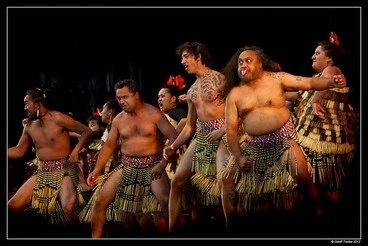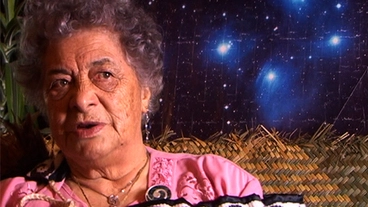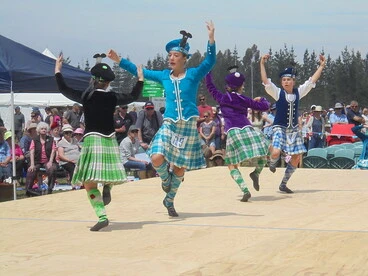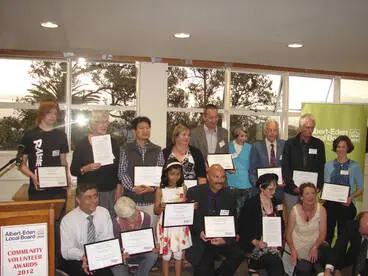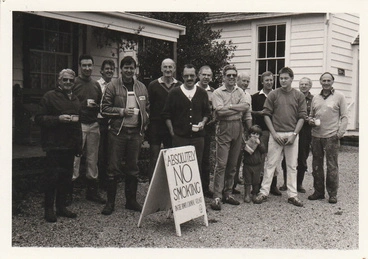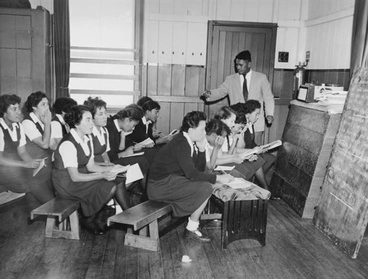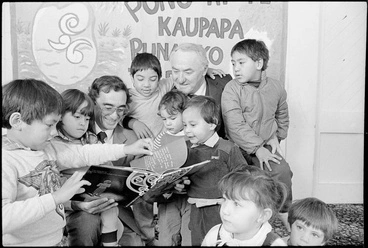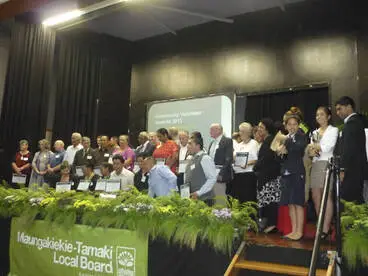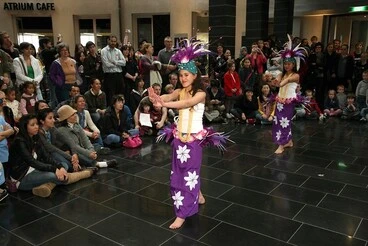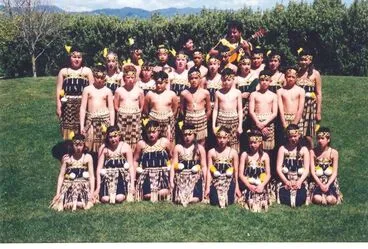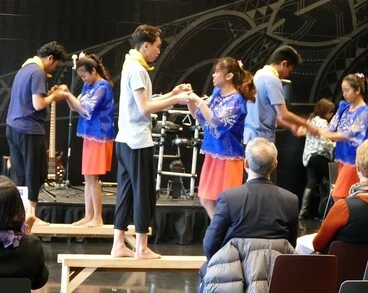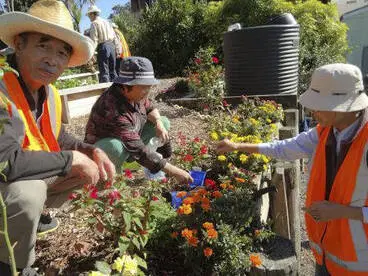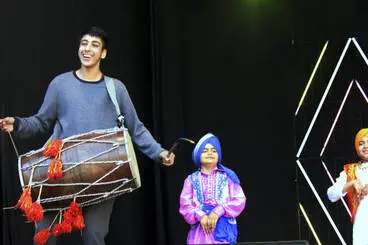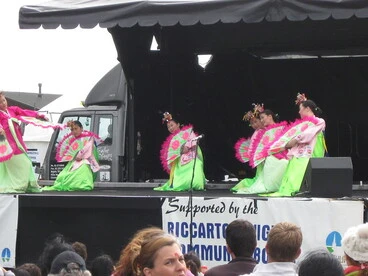Social and Cultural Sustainability
A DigitalNZ Story by National Library Services to Schools
Auckland Secondary Schools Maori and Pacific Islands Cultural Festival, Manukau City. Samoan performer, De La Salle College
Museum of New Zealand Te Papa Tongarewa
BACKGROUND
Social and cultural sustainability is the way we as a nation ensure the wellbeing of our community by recognising, developing and sustaining basic human needs like human rights, equality, health, culture and religion now and into the future.
CONTENTS
This story on social and cultural sustainability covers the following:
- What is social sustainability
- Recognising social sustainability
- What is cultural sustainability?
- What is culture?
- Examples of social & cultural sustainability
- Preserving our social and cultural organisations and history
- The importance of language in social and cultural sustainability
- Quick facts
- Glossary
- Supporting resources.
- Visual examples of cultural and social groups in New Zealand
SOCIAL SUSTAINABILITY
“I believe New Zealand can aim to be the first nation to be truly sustainable – across the four pillars of the economy, society, the environment, and nationhood." (Prime Minister Helen Clark 2007)
What is Social Sustainability?
Social sustainability has people at its centre. It recognises that people and communities have needs, values, shared experiences etc. and these must be addressed when planning for sustainable development. The two other sustainable ‘pillars’- economic and environmental - have a profound impact on social sustainability and social sustainability heavily influences them in return. Other factors influencing social sustainability include:
- individual and collective health
- standards of living
- human rights.
Social sustainability then is about improving the lives of people by establishing and promoting high quality long-term social wellbeing.
4. Sustainability and Social and Cultural Aspirations
Radio New Zealand
Identity is at the heart of it all
Radio New Zealand
13th Multicultural Festival 2012 23
Tauranga City Libraries
RECOGNISING SOCIAL SUSTAINABILITY
Social sustainability’s people-centred approach to improving our lives recognises all people regardless of their status, origin gender, colour, and culture and addresses the following fundamentals.
Rights
All people have rights to have an adequate standard of living, to shelter, clean water and air.
Examples
Paying workers the living wage allows workers to pay for the necessities of life and participate as an active citizen in society.
The Aotearoa New Zealand Homelessness Action Plan (2020-2023) has been developed to prevent and reduce homelessness.
Equality
All people have the right to recognised, valued and to be equal. This includes vulnerable ethnic, gender, and employment groups.
Examples
He Korowai Oranga is New Zealand’s Māori Health Strategy, that guides the Government and the health and disability sector to achieve the best health outcomes for Māori.
Rainbow Youth NZ helps queer & gender diverse youth all over Aotearoa to feel valued, recognised and supported in their local communities.
Civic participation
All disadvantaged and vulnerable groups have a right to voice their concerns and fully interact with society.
Examples
Treaty-principles -participation is about equality of opportunity and outcomes. Informed civic participation is a key aspect of the New Zealand Curriculum’s future focus principle.
Social planning by local and national government involves understanding and incorporating the voices and aspirations of all people and communities.
13th Multicultural Festival 2012 06
Tauranga City Libraries
CULTURAL SUSTAINABILITY
The pillars of sustainability
There are three pillars of sustainability:
- environmental
- economic
- social.
Cultural sustainability falls under the social pillar. However, there is growing support and awareness that culture should have a separate pillar.
This recognises the importance of culture and how it underpins all three pillars. For example, in New Zealand, the cultural practice of kaitiakitanga is a recognised cultural guide or value that underpins environmental sustainability.
While under economic sustainability the Maori concept of ensuring good ora (health) of not just whanau but ‘other’ family like, awa, moana or maunga (to maintain or increase their mauri) places a huge responsibility on an extractive industry like mining, intensive dairy farming, and overfishing.
WHAT IS CULTURAL SUSTAINABILITY?
Cultural sustainability is recognising and actively keeping cultural beliefs and practices alive. This not only refers to our dominant culture (Pakeha New Zealand) but all the cultures that make-up New Zealand and in particular te ao Māori.
Cultural sustainability celebrates our multicultural society while also recognising the original inhabitants of Aotearoa as the Tangata Whenua - the original inhabitants of Aotearoa New Zealand.
Examples of cultural sustainability in New Zealand world include:
- support and recognition for Te Matatini National Kapa Haka Festival
- active conservation of heritage Māori Marae and significant colonial buildings
- the celebration of cultures and religion through events and festivals like Matariki, Holi, and the Chinese New Year.
WHAT IS CULTURE?
Culture is who we are and who we identify with. It is commonly defined as a shared collection of human knowledge (like values, morals, beliefs, customs) and actions arising from these. It is expressed and transmitted through language, religion, cuisine, and the arts (like music, dance, writing).
Culture is transmitted to younger generations by socialization, that is, through parents, wider family members, friends and through public and social spaces like home, school, churches and workplaces.
Different cultures can overlap. For example, you could be a New Zealand Chineses Christian or you could have parents from different cultural backgrounds, like Maori and Samoan.
Culture defines who we are through a million things, how we dress, what we eat, who we talk to, how we express happiness or sadness. Crucially, underpinning this is language. Language is the core of every culture.
Māori culture
Tikanga Māori refers to the rich cultural system of values, behaviours and guidelines practised today that have been handed down through the generations.
Māori culture is expressed, passed down and sustained through te reo Māori and activities like kapa haka and waiata (traditional dance and song), carving, (whakairo) and the recitation of genealogies (whakapapa). An everyday example of the latter is the pepeha -a common way for speakers to introduce, identify and share their cultural connections to whenua and tupuna with an audience.
Western culture
Western culture is a rich culture that began with Ancient Greece and Ancient Rome and spread throughout Europe. It has subsequently been heavily influenced by Christianity, the Industrial and Scientific Revolutions, the Enlightenment and capitalism.
Centuries ago Europeans immigrated to places like New Zealand, Australia and America and established colonies. There they overran indigenous societies and established Western culture as the dominant culture.
Classical Kapa Haka - at ASB Classical Sparks in the Park
Manatū Taonga, the Ministry for Culture and Heritage
Ngāi Tahu Tourism
Manatū Taonga, the Ministry for Culture and Heritage
Wai 262
NZ On Screen
EXAMPLES OF SOCIAL AND CULTURAL SUSTAINABILITY
Māori tourism in the 2000s
Māori art and performance have been key features of the Māori tourist industry – so tourism has played a role in the retention of Māori culture and language, especially around Rotorua.
In the early 2000s scenery was the big drawcard for overseas visitors, but interest in Māori culture was growing, part of a worldwide expansion in cultural tourism.
In 2008 the council noted that there were more than 350 Māori tourism businesses operating in New Zealand. Of these, 37% were guided tours, 15% were accommodation, 15% were arts and crafts, 12% were attractions, 11% were retail, 7% were eating out, 5% were transport, 5% were concerts and hāngī, and 1% were marae stays. The Ministry of Tourism estimated that in 2006, 567,200 tourists (80% international and 20% domestic tourists) experienced Māori cultural activities in New Zealand.
Source: Te tāpoi Māori – Māori tourism - Resurgence of the Māori tourist industry, Te Ara - the Encyclopedia of New Zealand
The first Fiji association
In 1977 the Fiji Association was established in Auckland. It organised sporting and cultural events and sponsored Indian dancers and musicians from Fiji and India. The association has collected funds for hurricane relief in Fiji and to assist Fijians requiring medical treatment in New Zealand. It has also made submissions to public bodies in New Zealand on issues relating to Indian cultures and religions, immigration and education.
Source: Fijians - A sense of community, Te Ara - the Encyclopedia of New Zealand
Kapa haka in the 21st century
By the 21st century kapa haka was a firmly established vehicle for sustaining and developing Māori language and culture. Tens of thousands of participants competed, while many more practitioners regularly enjoyed kapa haka as a non-competitive social activity.In addition to the national Te Matatini competition, local and regional events attract dozens of teams and thousands of spectators. Te Ahurea Tino Rangatiratanga is the Auckland regional secondary schools’ kapa haka competition, held annually since 2000. Te Mana Kuratahi is the national primary schools’ competition.
Source: Kapa haka – Māori performing arts - Kapa haka in the 21st century, Te Ara - the Encyclopedia of New Zealand
Scottish highland traditions
Most Scots who came to New Zealand were Lowlanders, but they took the emblems and activities that proclaimed their identity from the Highlands. They adopted popular Highland symbols – clan societies, kilts, piping and Highland games – which were more romantic than the history and culture of the Lowlands.
The identity of Waipū settlers, originally defined by kinship, religion and the Gaelic language, was later expressed through participation in the Caledonian games, first held in 1871. Caledonian gatherings (Caledonia is the Latin word for North Britain) celebrated aspects of Scottish identity in the south from the 1860s.
Scotland left its impression on sport with golf and curling, first played in central Otago by gold miners. Knitting owes its popularity to Scottish immigrants. So does whisky. Porridge, shortbread and scones (if not haggis), all Scottish in origin, appear on everyday New Zealand menus.
Source: Scots - Scottish culture, Te Ara - the Encyclopedia of New Zealand
Cultural festivals
New Zealand’s population became much more diverse after the 1980s. Ethnic festivals are now commonplace in towns and cities. Some are festivals of individual ethnic groups (Indian New Zealanders now, for example, commonly celebrate Diwali, the Festival of Lights, in public) while others bring together representatives of a range of cultures.
Source: Society - The people of New Zealand, Te Ara - the Encyclopedia of New Zealand
Wai 262
Wai 262 was a Waitangi Tribunal claim about the recognition of rights around, and control of, traditional Māori knowledge, customs and relationships with the natural environment. Commonly known as the flora and fauna claim, it was first lodged in 1991 and became one of the tribunal's most complex and lengthy cases – the report was not released until 2011. This newsclip features Saana Murray, the only one of the original six claimants still living when the report was released.
Source: Intellectual property law - New Zealand intellectual property legislation, Wai 262, Te Ara - the Encyclopedia of New Zealand
Highland dancers
Christchurch City Libraries
Te Papa
Manatū Taonga, the Ministry for Culture and Heritage
Lotto; $5 million super draw; Priddles Hairdressers and Lotto clowning for the occasion
Upper Hutt City Library
Christmas in Greerton Village (2005)
Tauranga City Libraries
PRESERVING OUR SOCIAL AND CULTURAL ORGANISATIONS AND HISTORY
Cultural Institutions
To support cultural and social sustainability, society actively protects and makes accessible important cultural and social resources and taonga. This is done by storing them in institutions and allowing the public to visit, interpret and engage with the cultural objects (and their stories) physically and digitally. Examples are museums, libraries, marae, and churches. Specific examples include:
- Tūrangawaewae marae.
- The Museum of New Zealand Te Papa Tongarewa
- Auckland Art Gallery Toi o Tāmaki
- Alexander Turnbull Library
- The Holocaust Centre of New Zealand.
Active preservation
Some organisations like the following also actively preserve our cultural history (like buildings and books):
- Heritage New Zealand — Pouhere Taonga preserves Aotearoa New Zealand’s important cultural and heritage places and buildings.
- Auckland War Memorial Museum — tells the story of New Zealand, its place in the Pacific and its many peoples and their evolving identity.
- Department of Conservation — cares for places that shaped New Zealand’s history including thousands of important Maori sites.
Other institutions also actively pass on cultural learning and collective memory to specific cultural groups.
Te Wānanga o Raukawa is one example. This Māori tertiary institution provides a distinctive Māori focus (based on tikanga and kaupapa tuku iho) to enable their students to understand te ao Māori, te reo Māori and further inspire their whānau, and iwi.
Non-profit institutions
Other ways we sustain and retain our culture and social bonds are through funding by lotteries and not-for-profit organisations like:
Community Organisations Grants Scheme (COGS) — gives grants to non-profit organisations delivering community-based social services
Community Trusts of New Zealand — provides funding for a range of local projects.
The Lottery Grants Board — Te Puna Tahua distributes the profits made from New Zealand state lotteries (like Lotto and Instant Kiwi,) out to New Zealand communities. These profits go directly to fund community groups and national cultural organisations like:
- Sport New Zealand
- Creative New Zealand
- New Zealand Film Commission.
Requests for the above lottery funding must take into consideration criteria like:
- have regards to the needs and aspirations of Māori
- considering the needs of older people, Pacific people and other ethnic communities, women and youth, people with disabilities.
while also contributing to objectives like:
- promoting community wellbeing and address disadvantage
- promoting community participation, inclusion and identity.
Service clubs
Service clubs originated in the American Midwest. Like other male clubs, they offered fraternal socialising, free of political opinions and religious beliefs – and added a primary focus on community service. Service clubs boomed after the Second World War. By the 1970s it was claimed there was a higher per-capita membership of Rotary, Lions and Jaycees in New Zealand than in any other country. Membership declined from the 1980s as alternative entertainments emerged, and expectations of shared parenting made it less acceptable for men to spend their free time on male-only projects.
Source: Men’s clubs - Service clubs, Te Ara - the Encyclopedia of New Zealand
Te Wānanga o Raukawa
Manatū Taonga, the Ministry for Culture and Heritage
Community Awards 2012.
Auckland Libraries
THE IMPORTANCE OF LANGUAGE IN SOCIAL TO CULTURAL SUSTAINABILITY
Two key elements of society are culture and language. Both are essential to human identity and are crucial for sustainable development. In the last 50 years Māori language and culture has undergone through a remarkable revival.
Te reo Māori
The Māori language is an official language of New Zealand, and in recent years has undergone a revival. However, it is still threatened and, according to the 2006 census results, was spoken by only one in four Māori. Approximately 25,000 non-Māori could speak the language.
Culture
Māori culture is going through enormous change, with the establishment of new institutions and organisations. These include:
- the creation of Māori educational institutions where teaching and learning is conducted substantially in the Māori language. In 2001 there were over 500 kōhanga reo (language nests), teaching over 10,000 preschool children; over 50 kura kaupapa Māori (teaching schoolchildren in full Māori-language immersion programmes); and three whare wānanga (tertiary institutes).
- the rearrangement and strengthening of tribal structures and councils
- the recapitalisation of tribally owned assets
- the establishment of over 20 Māori radio stations and two television channels
- Māori political representation, with 29 MPs of Māori background in Parliament in 2018.
Source: Māori - People and culture today, Te Ara - the Encyclopedia of New Zealand
Teaching te reo Māori
Manatū Taonga, the Ministry for Culture and Heritage
Visit to a kōhanga reo
Manatū Taonga, the Ministry for Culture and Heritage
Te Taura Whiri i te Reo Māori
Manatū Taonga, the Ministry for Culture and Heritage
QUICK FACTS
- The wold culture comes from the Latin word “colere” meaning to tend the earth or soil to cultivate or nurture it.
- In the early 16th century culture also came to mean cultivating the mind as well as the soil.
- The roots of Western culture lie in the Greco-Roman Classical Period and also in the religion called Christianity.
- Culture is an important factor for economic development and creating wealth
- For Māori a word that’s close to the European concept of sustainability is manaaki. It means to means to cherish, conserve, and sustain.
- New Zealand's first cultural sustainability conference was held in 2017.
- One group at the conference came up with a definition for cultural sustainability as "the recognition and celebration of difference and diversity, working towards understanding our place on this planet, through transformative translation and storytelling.”
- There are 17 UN Sustainable Development Goals. A number of these indirectly address aspects of cultural sustainability.
- The Department of Conservation looks after approximately 10,000 Māori sites, many of cultural and spiritual significance.
- A wānanga teaches aspects of āhuatanga Māori (Māori tradition) knowledge according to tikanga Māori.
GLOSSARY
The definitions below are taken from the Oxford Learner's Dictionary and Te Aka.
capitalism — an economic system in which a country’s businesses and industry are controlled and run for profit by private owners.
cuisine — a style of cooking.
culture— the customs and beliefs, art, way of life and social organization of a particular country or group.
The Enlightenment — the period in the 18th century in Europe when writers and scientists began to argue that science and reason were more important than religion and tradition.
homelessness — the state of having no home.
indigenous — belonging to a particular place rather than coming to it from somewhere else.
living wage — a wage that is high enough for somebody to buy the things they need in order to live.
morals — standards or principles of good behaviour.
shelter — the fact of having a place to live or stay, considered as a basic human need.
standard of living — the amount of money and level of comfort that a particular person or group has.
values — the quality of being useful or important.
wellbeing— general health and happiness.
TE REO MĀORI
awa — a river.
kaitiakitanga — guardianship, stewardship, trusteeship, trustee.
maunga — mountain, mount, peak..
moana — sea, ocean, or large lake.
mauri— life principle, life force, vital essence.
pepeha — set form of words, formulaic expression, saying of the ancestors.
taonga— treasure, anything prized.
te ao Māori — the Māori world view.
te reo Māori — Māori language.
tupuna ancestors, grandparents.
Location of wānanga campuses in New Zealand, 2012
Manatū Taonga, the Ministry for Culture and Heritage
SUPPORTING RESOURCES
Agenda 21 for culture — the first document with a worldwide mission that advocates establishing the groundwork of an undertaking by cities and local governments for cultural development.
Australian Ellen van Neerven— is a talented, award winning young writer and poet who talks about identity in many shapes and forms.
Clubs New Zealand Inc — the site of the organisation which represents over 300 chartered clubs.
Cultural tourism — Cultural tourism is a type of tourism involving travel to experience the distinctive character of a place, and its peoples.
Goals — the UN Sustainable Development Goals are the blueprint to achieve a better and more sustainable future for all.
Human Rights in Aotearoa New Zealand — all people have human rights.
The importance of culture for sustainability— sustainable development is based on the three-pillars model.
The importance of diversity in NZ— imagine a New Zealand without vineyards, wonton soup, Diwali (the festival of lights) or the art of John Pule ...
Language weeks can create culture of acceptance — language weeks in schools are an opportunity for students from different ethnic groups to be loud and proud about their cultural identities.
Māori identity, language and culture to thrive at Te Matatini 2017 — te Matatini National Kapa Haka Festival celebrates authentic Māori identity, language and culture and links it to school life.
Matariki — supporting Māori food sovereignty and sustainable practices over Matariki.
New Zealand is a model of cultural education— blog by an American teacher about the inclusion of te reo Māori and tikanga in the New Zealand education system and embracing bilingualism.
Office of Ethnic Communities — our vision is flourishing ethnic diversity; thriving New Zealand.
Peoples— explore stories about the many peoples of New Zealand.
Pepeha— this website helps all New Zealanders introduce themselves in Te Reo Māori, through Pepeha.
Social change and social sustainability — challenges for the planning profession.
Social inclusion and participation — a guide for policy and planning.
Sustainability— social and cultural sustainability in Canada.
Sustainable New Zealand — what is the way forward?
Te Ara Wai: journeys — experience places of local and national importance in this free, self-guided tour of culturally significant sites throughout the Waipā district.
The next stage for WAI 262– looking to the future of Māori culture and identity.
Tikanga — what are tikanga Māori values?
The whare wananga — in pre-European times Māori had evolved whare wānanga (schools of learning) to pass down and sustain and preserve their culture.
Community Volunteer Awards 2013.
Auckland Libraries
EXAMPLES OF CULTURAL AND SOCIAL GROUPS IN AOTEAROA NEW ZEALAND
Religious communities
Manatū Taonga, the Ministry for Culture and Heritage
Polynesian cultural group
Manatū Taonga, the Ministry for Culture and Heritage
Grand Parade at the Waipū Highland Games, 2012
Manatū Taonga, the Ministry for Culture and Heritage
Porirua cultural group
Manatū Taonga, the Ministry for Culture and Heritage
World on Your Plate: Cook Islands
Auckland War Memorial Museum Tāmaki Paenga Hira
Taitoko Cultural Group, group photo
Kete Horowhenua
Filipino Cultural Youth Group performing Sayaw sa Bangko ( Bench Dance)
Christchurch City Libraries
Music in the community
DigitalNZ
The Swiss Kiwi Yodel Group
Manatū Taonga, the Ministry for Culture and Heritage
Waitangi Day: Community event, 2011
Manatū Taonga, the Ministry for Culture and Heritage
Atafu Tokelau community group
Manatū Taonga, the Ministry for Culture and Heritage
AEPA group working at New Lynn community garden.
Auckland Libraries
Chinese community champions
Manatū Taonga, the Ministry for Culture and Heritage
Groups doing Bhangra dancing.
Auckland Libraries
Christchurch Korean Community School
Christchurch City Libraries
Community groups: Auckland students' association
Manatū Taonga, the Ministry for Culture and Heritage
This story was curated and compiled by Te Puna Mātauranga o Aotearoa | National Library of New Zealand, Services to Schools staff, May 2020.

